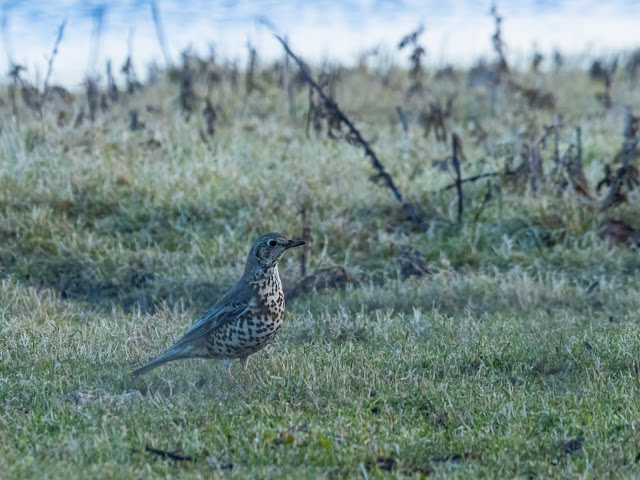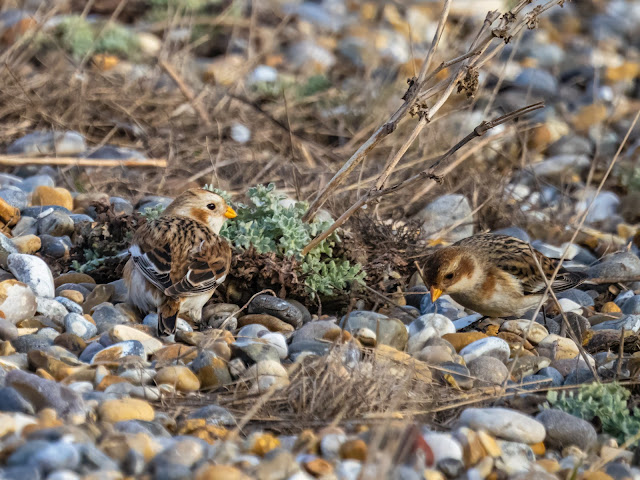31st January 2023
My first record of the day was the large numbers of Pink-footed Geese flying over Deepdale Camping and Rooms from 7:15 a.m. to 7:25 a.m. These birds had presumably left their overnight roost on the nearby saltmarshes to fly out to the farmland to feed for the day.
Just 2 minutes after leaving Deepdale Camping and Rooms, I saw my first Red Kite of the day.
My first visit of the day was to Holkham National Nature Reserve and specifically Holkham beach and bay and the freshmarsh either side of Lady Anne’s Drive which runs down to the car park.
Before turning into Lady Anne’s Drive, I stopped at a small lay-by on the A149 to scan for Eurasian White-fronted Geese. This species is regularly recorded during the winter months on the freshmarsh from this vantage point although, unlike during my last visit in December 2022, I was unsuccessful on this occasion. So, after missing out on this species at RSPB North Warren Nature Reserve in Suffolk on my way up to Norfolk, this was a second "miss".
However, I was able to record the following: Wigeon (++), Lapwing (++), Shelduck (c.20), Egyptian Goose (1), Grey Heron (1), Marsh Harrier (1)
Holkham National Nature Reserve is England's largest National Nature Reserve and it is situated on the Norfolk coast between Burnham Overy Staithe and Blakeney. It is managed by Natural England with the co-operation of the Holkham Estate.
Holkham National Nature Reserve comprises 3900 hectares of a wide range of habitats including grazing marsh, pine woodland, scrub, salt marsh, sand dunes and foreshore.
The reserve is part of the North Norfolk Coast Site of Special Scientific Interest and the larger area is additionally protected through Natura 2000, Special Protection Area and Ramsar listings and it is part of both an Area of Outstanding Natural Beauty and a World Biosphere Reserve.
Holkham National Nature Reserve is a huge area and
I accessed the site via Lady Anne’s Drive (opposite the entrance to Holkham
Hall) and the Holkham Beach car park.
My visit to Holkham beach and bay and the freshmarsh either side of Lady Anne’s Drive proved to be very productive as I expected it to be although I was disappointed not to see any Shorelarks which have again returned to the beach this winter. Fortunately, I was able to locate this species at NWT Holme Dunes later during my trip.
The complete absence of the usual huge flock of Common Scoters with a few Velvet Scoters amongst them was also a complete surprise plus I also failed to locate both the Slavonian Grebe and the Red-necked Grebe which had been reported regularly prior to my visit.
Additions to my 2023 UK year list: Red-throated Diver, Great Northern Diver, Red-breasted Merganser, Sanderling, Golden Plover, Little Egret, Grey Partridge, Mistle Thrush
Highlights from my visit included the following:
Lady Anne’s Drive: Pink-footed Goose (++), Dark-bellied Brent Goose (++), Greylag Goose (c.20), Egyptian Goose (2), Mute Swan (2), Wigeon (+++), Teal (+++), Shoveler (4), Lapwing (+++), Golden Plover (c.50), Common Snipe (1), Curlew (1), Black-tailed Godwit (3), Common Redshank (1), Red Kite (1), Marsh Harrier (2), Grey Partridge (2), Redwing (c.5), Mistle Thrush (2), Skylark (heard singing only)
Holkham woods, beach and sand dunes: Little Egret (1), Red Kite (4), Goldcrest (heard only) Coal Tit (heard only)
Holkham bay (sea): Great Northern Diver (1), Red-throated Diver (7), Red-breasted Merganser (2 males), Cormorant (c.150)
Holkham bay (foreshore): Sanderling (c.10), Oystercatcher (c.10)
Birds are very distant at Holkham Bay requiring telescope views so I was unable to get any photos.
However, I did get a few photos of birds on or over the freshmarsh on the eastern side of Lady Anne’s Drive, including my first ever photos of a Mistle Thrush.
Photo: Common Redshank
After spending several hours at Holkham National Nature Reserve, I drove the short distance east to NWT Cley and Salthouse Marshes.
I concentrated specifically on the East Bank, The Serpentine, Arnolds Marsh and the shoreline shingle ridge with the specific target being the flock of Snow Buntings which had been reported regularly prior to my visit.
I successfully located the Snow Buntings on the shoreline shingle ridge just to the east of the end of East Bank. This was a further addition to my 2023 UK year list and I spent some time photographing these birds. Presumably this flock is the one that had been recorded at Holkham beach and bay earlier in the winter since there were no recent records from that location.
Additions to my 2023 UK year list: Snow Bunting, Pintail
Highlights from my visit included the following: Pink-footed Goose (c.100), Wigeon (++), Teal (+), Shoveler (c.10), Gadwall (c.10), Mallard (c.10), Shelduck (6), Pintail (1 male), Black-tailed Godwit (c.50), Golden Plover (c.50), Dunlin (c.50), Common Redshank (c.10), Grey Plover (1), Curlew (1), Ruff (1), Little Egret (1), Snow Bunting (c.70), Marsh Harrier (1), Atlantic Grey Seal (1)
Photo: Snow Buntings
Photo: Snow Buntings
Photo: Snow Buntings
Photo: Snow Bunting
Photo: Snow Bunting
Photo: Snow Buntings
Photo: Snow Bunting
Photo: Snow Bunting
Photo: Snow Buntings
Photo: Snow Bunting
Photo: Snow Buntings
Photo: Snow Bunting
Photo: Snow Bunting
Photo: Snow Bunting
Photo: Snow Bunting
Photo: Snow Bunting
Photo: Atlantic Grey Seal
Photo: Atlantic Grey Seal
After my visit to NWT Cley and Salthouse Marshes, I drove less than 3 miles south to the village of Glandford and the home of Cley Spy.
My intention was not to buy a new telescope or pair of binoculars but to see a much-reported and photographed Long-eared Owl that had been present since the end of December 2022.
Long-eared Owl is not a rare species but it is very difficult to locate and see well. Prior to my visit to Cley Spy, I had only seen this owl species 7 times in the UK, my last record being in 2019.
At Cley Spy, a viewing area had been set up outside the rear of the building which provided amazing views of a Long-eared Owl sitting prominently out in the open rather than hidden away deep in a bush as is normally the case.
I was able to take a number of photos, my first ever of a Long-eared Owl.
Photo: Long-eared Owl
Here is a Twitter post and video from Cley Spy ....
Snack time ………🐀 #birding #owls #norfolk pic.twitter.com/aTZWAomfzz
— CleySpy (@CleySpy) January 30, 2023
Long-eared Owl proved to be
the third owl species recorded during my trip (after already recording Barn
Owl and Tawny Owl) but my final total for my trip should
really have been 4 owl species but I very surprisingly failed to see a Short-eared
Owl anywhere.
Following this amazing encounter with such an elusive species, I decided to drive south east to the area around St Benet’s Abbey before moving on to NWT Hickling Broad and Marshes. I was hoping to see more Bewick's Swans at this location although the previously reported flock had evidently moved on. However, I was able to take some photos of an untypically confiding female Kestrel along the road leading to the abbey car park.
Photo: female Kestrel
My day concluded at NWT Hickling Broad and Marshes and specifically the Stubb Mill viewpoint.
NWT Hickling Broad and Marshes is the largest of the Norfolk Broads and is a year-round haven for wildlife and holds a significant percentage of the UK population of Common Crane as well as important breeding numbers of Bittern, Marsh Harrier and Bearded Tit.
In winter, large numbers of Marsh Harriers roost in the reedbed north east of Stubb Mill and Hen Harrier, Merlin and Barn Owl can also often be seen. Interesting mammals include the introduced Chinese Water Deer plus Red Deer and Otter.
I spent around 2 hours at the Stubb Mill viewpoint and stayed until it was almost completely dark. For the first time in many years of visiting this site during the winter months, I failed to hear let alone see any Common Cranes coming in to roost.
Additions to my 2023 UK year list: Hen Harrier
Highlights from my visit included the following: Tawny Owl (male heard calling and then seen flying out of the trees near Stubb Mill), Barn Owl (1), Hen Harrier (1 male), Marsh Harrier (at least 20 coming in to roost), Common Buzzard (1), Kestrel (2), Kingfisher (1), Grey Heron (2), Pink-footed Goose (++++), Egyptian Goose (2), Greylag Goose (2), Mute Swan (2), Teal (c.100), Mallard (c.30), Gadwall (c.30), Shoveler (c.30), Shelduck (24), Chinese Water Deer (3)
#DefendNature .... Please help save and enhance our laws that protect our environment and wildlife
💚🦆 🦉🦋🐝🦊🦡🌼 🌳💚
Stay safe, stay well, stay strong, stay connected with nature










































No comments:
Post a Comment
If you feel like commenting on my blog, you can contact me by completing the comment form below. I will respond to all comments and enquiries and constructive criticism will always be welcomed.